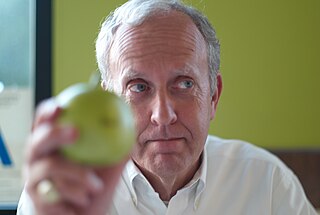Ubiquitous computing is a concept in software engineering, hardware engineering and computer science where computing is made to appear seamlessly anytime and everywhere. In contrast to desktop computing, ubiquitous computing implies use on any device, in any location, and in any format. A user interacts with the computer, which can exist in many different forms, including laptop computers, tablets, smart phones and terminals in everyday objects such as a refrigerator or a pair of glasses. The underlying technologies to support ubiquitous computing include the Internet, advanced middleware, kernels, operating systems, mobile codes, sensors, microprocessors, new I/Os and user interfaces, computer networks, mobile protocols, global navigational systems, and new materials.

Augmented reality (AR) is an interactive experience that combines the real world and computer-generated 3D content. The content can span multiple sensory modalities, including visual, auditory, haptic, somatosensory and olfactory. AR can be defined as a system that incorporates three basic features: a combination of real and virtual worlds, real-time interaction, and accurate 3D registration of virtual and real objects. The overlaid sensory information can be constructive, or destructive. As such, it is one of the key technologies in the reality-virtuality continuum.

A webcam is a video camera which is designed to record or stream to a computer or computer network. They are primarily used in video telephony, live streaming and social media, and security. Webcams can be built-in computer hardware or peripheral devices, and are commonly connected to a device using USB or wireless protocols.

VNC is a graphical desktop-sharing system that uses the Remote Frame Buffer protocol (RFB) to remotely control another computer. It transmits the keyboard and mouse input from one computer to another, relaying the graphical-screen updates, over a network. Popular uses for this technology include remote technical support and accessing files on one's work computer from one's home computer, or vice versa.

The Trojan Room coffee pot was a coffee machine located in the Computer Laboratory of the University of Cambridge, England. Created in 1991 by Quentin Stafford-Fraser and Paul Jardetzky, it was migrated from their laboratory network to the web in 1993, becoming the world's first webcam.

Project Athena was a joint project of MIT, Digital Equipment Corporation, and IBM to produce a campus-wide distributed computing environment for educational use. It was launched in 1983, and research and development ran until June 30, 1991. As of 2023, Athena is still in production use at MIT. It works as software that makes a machine a thin client, that will download educational applications from the MIT servers on demand.

The Department of Computer Science and Technology, formerly the Computer Laboratory, is the computer science department of the University of Cambridge. As of 2023 it employed 56 faculty members, 45 support staff, 105 research staff, and about 205 research students. The current Head of Department is Professor Alastair Beresford.
A webcast is a media presentation distributed over the Internet using streaming media technology to distribute a single content source to many simultaneous listeners/viewers. A webcast may either be distributed live or on demand. Essentially, webcasting is "broadcasting" over the Internet.

Scott Fisher is the Professor and Founding Chair of the Interactive Media Division in the USC School of Cinematic Arts at the University of Southern California, and Director of the Mobile and Environmental Media Lab there. He is an artist and technologist who has worked extensively on virtual reality, including pioneering work at NASA, Atari Research Labs, MIT's Architecture Machine Group and Keio University.

Michael John Caldwell Gordon was a British computer scientist.

The College of Technology and Engineering (CTAE), is a public engineering college located in Udaipur, Rajasthan, India. It is one of the top ranking engineering institute of the state offering varied courses in engineering.
Peter Robinson is Professor Emeritus of Computer Technology at the University of Cambridge Computer Laboratory in England, where he works in the Rainbow Group on computer graphics and interaction. He is also a Fellow of Gonville and Caius College and lives in Cambridge.
In computing, the term remote desktop refers to a software- or operating system feature that allows a personal computer's desktop environment to be run remotely from one system, while being displayed on a separate client device. Remote desktop applications have varying features. Some allow attaching to an existing user's session and "remote controlling", either displaying the remote control session or blanking the screen. Taking over a desktop remotely is a form of remote administration.

Alexander G. Fraser, also known as A. G. Fraser and Sandy Fraser, was a noted British-American computer scientist and the former Chief Scientist of AT&T.
Bruce Howard McCormick (1928–2007) was an American computer scientist, Emeritus Professor at the Department of Computer Science, and founding director of the Brain Networks Lab at Texas A&M University.

Godfrey Harry Stafford CBE, FRS, was a British physicist and directed the Rutherford Appleton Laboratories from 1969 to 1981. He went on to be a master at St Cross College, Oxford and president of the Institute of Physics. In 1950 Dr. Stafford married Helen Goldthorp Clark, an Australian biologist. He has a son and twin daughters and lived near Oxford.

Gonville and Caius College, often referred to simply as Caius, is a constituent college of the University of Cambridge in Cambridge, England. Founded in 1348 by Edmund Gonville, it is the fourth-oldest of the University of Cambridge's 31 colleges and one of the wealthiest. In 1557, it was refounded by John Caius, an alumnus and English physician.

Andrew John Schofield is an academic and administrator who is the vice-chancellor of Lancaster University. A theoretical physicist, he was previously a pro-vice-chancellor at the University of Birmingham and head of its College of Engineering and Physical Sciences. As an academic, his research focus is in the theory of correlated quantum systems, in particular non-Fermi liquids, quantum criticality and high-temperature superconductivity.
Series 43 of University Challenge began on 15 July 2013 on BBC Two.
Professor John Dixon Mollon DSc FRS. is a British scientist. He is a leading researcher in visual neuroscience. His work has been cited over 15,000 times.














